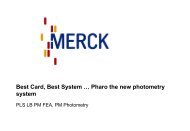Inhibitor SourceBook™ Second Edition
Inhibitor SourceBook™ Second Edition
Inhibitor SourceBook™ Second Edition
You also want an ePaper? Increase the reach of your titles
YUMPU automatically turns print PDFs into web optimized ePapers that Google loves.
Transmembrane receptors of various hormones are<br />
coupled to adenylate cyclase (AC) via heterotrimeric<br />
G-proteins. Ligand binding to the receptor changes the<br />
receptor conformation, allowing it to associate with a<br />
G-protein. This results in the activation of the specific<br />
G-protein via exchange of GTP for GDP bound to the asubunit<br />
of the G-protein. The activated G-protein in turn<br />
activates AC resulting in the conversion of ATP to cAMP.<br />
cAMP then acts to regulate a wide variety of cellular<br />
processes. AC can couple with both the stimulatory and<br />
inhibitory G-proteins (G s and G i ). Interaction with G s<br />
stimulates its activity and interaction with G i inhibits its<br />
enzymatic activity.<br />
At least nine different isoforms of AC have been<br />
reported that differ in their regulatory properties and<br />
are differentially expressed in various tissues. They<br />
are integral membrane proteins that are composed of<br />
two cytoplasmic domains and two membrane-spanning<br />
domains, each of which contains six transmembrane<br />
spans. The amino acid sequence of each cytoplasmic<br />
domain, which is thought to contain a nucleotide (ATP)<br />
binding site, is well conserved among the various<br />
subtypes. Although ACs can exist in both particulate<br />
and soluble forms, the particulate form is more<br />
prevalent in mammals. Based on the conservation<br />
of their catalytic domains, three classes of ACs are<br />
described: class I-ACs are found in Gram-negative<br />
facultative anaerobes, such as E. coli; class II-“toxic'<br />
ACs, including calmodulin (CaM)-activated ACs<br />
are found in pathogenic bacteria, such as Bordetella<br />
Calbiochem • <strong>Inhibitor</strong> SourceBook<br />
Other <strong>Inhibitor</strong>s of Biological Interest<br />
Other <strong>Inhibitor</strong>s of Biological Interest<br />
Adenylate Cyclase <strong>Inhibitor</strong>s<br />
Adenylate Cyclase <strong>Inhibitor</strong>s<br />
pertussis and Bacillus anthracis; and class III-ACs are<br />
found in a wide variety of organisms ranging from<br />
bacteria to human. Class III-AC also include nine<br />
isoforms found in mammals, which are designated AC-<br />
1 to AC-9. These nine isoforms are stimulated by the<br />
a-subunit of G s -protein and by forskolin. ACs are also<br />
capable of receiving signals from a variety of other<br />
sources, such as G i -a, protein kinase A, C, CaM kinase,<br />
and Ca 2+ /CaM. Hormonal activation of CaM-dependent<br />
adenylate cyclase occurs at very low Ca 2+ levels. The<br />
activity of AC is inhibited by high levels of Ca 2+ , which<br />
also activates CaM-dependent phosphodiesterase.<br />
References:<br />
Insel, P.A., and Ostrom, R.S. 2003. Cell. Mol. Neurobiol. 23, 305.<br />
Cui, H., and Green, R. D. 200 . Biochem. Biophys. Res. Comm. 283, 07.<br />
Schwartz, J.H. 200 . Proc. Natl. Acad. Sci. USA 98, 3482.<br />
Sunahara, R.K., et al. 996. Annu. Rev. Pharmacol. Toxicol. 36, 46 .<br />
MacNeil, S., et al. 985. Cell Calcium 6, 2 3.<br />
Product Cat. No. Comments Size Price<br />
Adenylyl Cyclase Toxins <strong>Inhibitor</strong> 116845 (Ethyl-5-aminopyrazolo[1,5-a]quinazoline-3-carboxylate)<br />
A cell-permeable inhibitor of adenylate cyclase (IC 50 = 90 mM).<br />
Adenylyl Cyclase Type V <strong>Inhibitor</strong>,<br />
NKY80<br />
More online... www.calbiochem.com/inhibitors/AC<br />
116850 [2-Amino-7-(furanyl)-7,8-dihydro-5(6H)-quinazolinone]<br />
A cell-permeable, potent and selective inhibitor of adenylyl cyclase<br />
(AC) type V isoform (IC 50 = 8 .3 mM, 32 mM and .7 mM for type V,<br />
III, and II, respectively) in the presence of Gsx GTPrs-Forskolin.<br />
Angiotensin II, Human 05-23-0101 (DRVYIHPF)<br />
An inhibitor of adenylate cyclase activity in spontaneously<br />
hypertensive rats.<br />
2',5'-Dideoxyadenosine 288104 (2',5'-dd-Ado)<br />
A cell-permeable, non-competitive inhibitor of adenylate cyclase<br />
(IC 50 = 3 mM). Binds to the adenosine binding site.<br />
0 mg $ 00<br />
5 mg<br />
25 mg<br />
mg<br />
5 mg<br />
25 mg<br />
$60<br />
$2<br />
$23<br />
$34<br />
$ 35<br />
mg $53<br />
Technical Support<br />
Phone 800 628 8470<br />
E-mail calbiochem@emdbiosciences.com<br />
39



